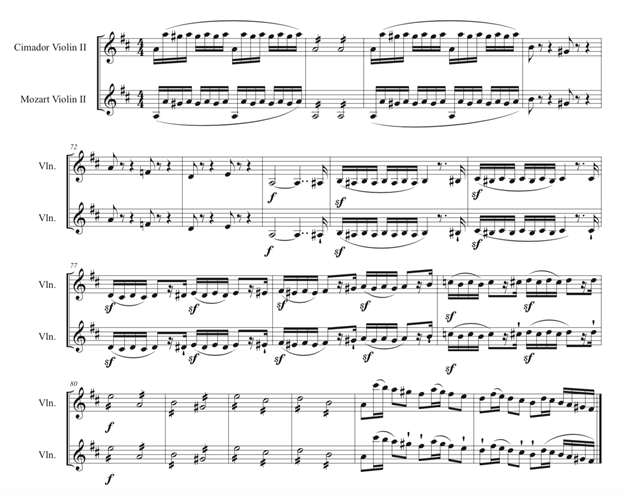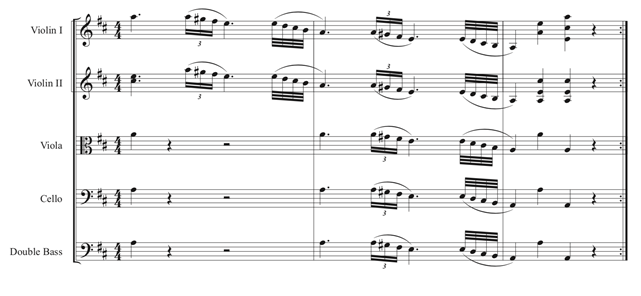Volume 15, June 2022
Different Strokes: Giambattista Cimador's chamber music arrangement of Mozart's Haffner (no. 35) and Paris (no. 31) Symphonies
by Mark Elliot Bergman
5. Slurs
Relative to the critical Neue Mozart-Ausgabe edition, Cimador's arrangement of Mozart's work in Symphony IV employs shorter slurred passages. Cimador, a string player himself, was often called upon to play violin or viola in the 1790s at social gatherings, and may have performed these arrangements himself (Lister, 2016, p.4). Given the depth of his understanding of string technique, the bowing choices Cimador made are surely intentional and reflect his approach to phrasing.
Cimador's alterations suggest changes in string performance technique and musical aesthetic preference between the late 1770s and early 1780s when the source material was composed and the early 19th century when the arrangements were published. Brown (1988) observed "during the first decade of the nineteenth century an aesthetic of string sound which stressed a singing style, expressive delivery, strong tone, forceful accents, and broad martelé bowstrokes in passagework seems to have been gaining ascendancy" (p. 101). Brown (1988) credits Giovanni Battista Viotti with spearheading this change and describes him as the "the greatest violinist of his day and the founder of a new style" of string playing at the turn of the 19th century (p. 102). Viotti's aforementioned praise for Cimador's arrangements are probably due (at least in part) to the latter's success in notating technical aspects of the string-playing aesthetics in vogue at the time and favored by Viotti.
In general, Mozart's source material has longer slurs. Mozart also slurs fast passages into the following strong beat. Cimador, by contrast, prefers shorter slurs and changing the bow direction on a strong beat following a fast passage. These alterations likely helped contemporary string players express the new strong and forceful playing style described by Brown (1988). An example of the alterations is clear in the Violin II part between bars 68 and 85 in the first movement.
Figure 2: Violin II parts; movement 1, m 68-85. Note how the Cimador edition breaks the slur in all the 16th note passages.
Cimador employs a similar approach to the cadential material at the end of the first movement's exposition. The critical Neue Mozart-Ausgabe includes slurs into the downbeat while the Cimador edition breaks the slur after the 16th-note triplets at the bar line.
Figure 3: First Movement of the Haffner Symphony, Cimador Edition (m. 92 – 95). Note that the slurs in the 32nd notes and 16th note triplets do not extend to the next note.
Figure 4: String Parts from the First Movement of Mozart's Haffner Symphony (m. 92 – 95). Note that the slurs in the 32nd notes and 16th note triplets extend to the next note.
|



